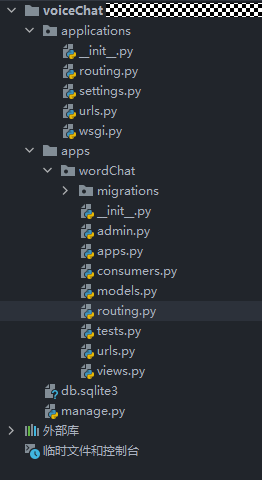技术栈:
前端:Vue3全家桶
后端:django、conda、channel
通信方式:websocket
业务场景:实现实时聊天系统,聊天内容广播至所有人,目前仅支持文字聊天,实时语音、屏幕共享等方式仍在钻研中
由于前端较为简单,所以先从后端入手
一、后端
1.1新建工程
创建django工程
使用下面这个命令检查电脑是否装了django
python
python -m django --version如果这行命令输出了一个版本号,证明你已经安装了此版本的 Django;如果你得到的是一个"No module named django"的错误提示,则表明你还未安装。
执行下面这个命令使用django创建工程
python
django-admin startproject applications这行代码将会在当前目录下创建一个 applications目录,。
在目录下创建apps文件夹以存放各个应用,然后cd到apps文件夹下创建应用
python
python manage.py startapp wordChat对照下面的文件结构来补全缺失的文件
文件结构如图:

1.2、配置conda环境
这里提供链接:配置conda环境
1.3、安装Channels
由于django本身不支持websocket,所以我们使用django官方推荐的第三方库Channels
这里需要安装Channels和channels_redis
python
pip install channels==2.1.7
pip install channels_redis==2.3.31.4、环境配置
先来到settings.py手动添加channels和你的自定义app
python
INSTALLED_APPS = [
# "daphne",
'django.contrib.admin',
'django.contrib.auth',
'django.contrib.contenttypes',
'django.contrib.sessions',
'django.contrib.messages',
'django.contrib.staticfiles',
'channels',
# 自定义app
'apps.wordChat'
]添加ASGI_APPLICATION
python
ASGI_APPLICATION = 'applications.routing.application'配置channels_layers
python
CHANNEL_LAYERS = {
"default": {
"BACKEND": "channels_redis.core.RedisChannelLayer",
"CONFIG": {
"hosts": [("localhost", 6379)],
"capacity": 1500,
"expiry": 10,
},
},
}然后在applications文件夹下新建routing.py文件(与url文件用处一样,区别在于routing.py是走websocket连接的),有多少个app就导入多少个app到routingList里面
python
"""
@describe websocket路由相关
@author
@date
"""
from channels.routing import ProtocolTypeRouter, URLRouter
from channels.auth import AuthMiddlewareStack
import apps.wordChat.routing as wordChat
routinglist = []
routinglist.extend(wordChat.websocket_urlpatterns)
# routinglist.extend(a.websocket_urlpatterns)
application = ProtocolTypeRouter({
'websocket': AuthMiddlewareStack(
URLRouter(
routinglist
)
)
})1.5、功能实现
接下来在wordChat文件夹下新建routing.py文件和consumers.py文件,routing.py的作用是让前端发来的接口找到对应的位置,consumers.py文件的作用是写接口逻辑
在routing.py中做如下配置
python
from django.urls import path
from apps.wordChat.consumers import ChatConsumer
websocket_urlpatterns = [
path('ws/chat/', ChatConsumer),
]在consumers.py中接口逻辑如下
python
from channels.generic.websocket import AsyncWebsocketConsumer
import json
import asyncio
import logging
import random
import string
from datetime import datetime
from urllib.parse import parse_qs
# 配置日志
logger = logging.getLogger(__name__)
class ChatConsumer(AsyncWebsocketConsumer):
def __init__(self, *args, **kwargs):
super().__init__(*args, **kwargs)
self.room_group_name = 'ops_coffee'
self.connected = False
self.heartbeat_task = None
self.client_id = None # 每个客户端唯一标识
self.client_name = "用户" # 客户端显示名称
async def connect(self):
# 检查是否已经连接
if self.connected:
await self.close(code=4000)
return
self.connected = True
# 加入房间组
await self.channel_layer.group_add(
self.room_group_name,
self.channel_name
)
# 获取查询字符串
query_string = self.scope.get('query_string', b'').decode('utf-8')
# 解析查询字符串
query_params = parse_qs(query_string)
# 获取 username 参数
username_list = query_params.get('username', [])
self.client_name = username_list[0] if username_list else "匿名用户"
# 生成客户端唯一ID和名称
self.client_id = self.generate_client_id()
# self.client_name = self.scope['url_route']['kwargs'].get('username', None)
await self.accept()
logger.info(f"WebSocket 连接已建立, 客户端ID: {self.client_id}")
# 发送欢迎消息
await self.send_welcome_message()
# 启动心跳任务
self.heartbeat_task = asyncio.create_task(self.send_heartbeat())
logger.info("心跳任务已启动")
def generate_client_id(self):
"""生成8位随机客户端ID"""
return ''.join(random.choices(string.ascii_letters + string.digits, k=8))
async def send_welcome_message(self):
"""发送欢迎消息"""
welcome_message = (
f"欢迎来到聊天室!您的ID是 {self.client_id}, 名称是 {self.client_name}。\n"
"试试发送包含'帮助'、'时间'或'天气'的消息触发自动回复"
)
await self.send(text_data=json.dumps({
'type': 'system',
'message': welcome_message,
'client_id': self.client_id,
'client_name': self.client_name
}))
# 广播新用户加入消息
await self.channel_layer.group_send(
self.room_group_name,
{
'type': 'chat_message',
'message': f"{self.client_name} 加入了聊天室",
'sender_id': 'system',
'sender_name': '系统通知',
'is_system': True
}
)
async def disconnect(self, close_code):
# 标记连接已断开
self.connected = False
logger.info(f"WebSocket 断开连接,代码: {close_code}")
# 广播用户离开消息
if self.client_id:
await self.channel_layer.group_send(
self.room_group_name,
{
'type': 'chat_message',
'message': f"{self.client_name} 离开了聊天室",
'sender_id': 'system',
'sender_name': '系统通知',
'is_system': True
}
)
# 取消心跳任务
if self.heartbeat_task and not self.heartbeat_task.done():
self.heartbeat_task.cancel()
try:
await self.heartbeat_task
except asyncio.CancelledError:
logger.info("心跳任务已取消")
except Exception as e:
logger.error(f"等待心跳任务时出错: {str(e)}")
# 离开房间组
await self.channel_layer.group_discard(
self.room_group_name,
self.channel_name
)
async def receive(self, text_data):
# 检查连接状态
if not self.connected:
logger.warning("尝试在断开连接后接收消息")
await self.close(code=4001)
return
logger.debug(f"收到消息: {text_data}")
try:
data = json.loads(text_data)
message = data.get('message', '')
message_type = data.get('type', 'chat')
if message_type == 'chat' and message:
# 广播用户消息到所有客户端
await self.broadcast_user_message(message)
# 检查是否需要自动回复
if self.should_reply(message):
auto_reply = await self.generate_auto_reply(message)
await asyncio.sleep(1.5) # 添加延迟
await self.broadcast_auto_reply(auto_reply)
elif message_type == 'heartbeat':
# 处理心跳响应
logger.debug("收到心跳响应")
except json.JSONDecodeError:
logger.warning("消息JSON解析失败")
await self.send_error_message('消息格式错误,请发送有效的JSON')
except Exception as e:
logger.error(f"处理消息时出错: {str(e)}")
await self.send_error_message('处理消息时发生错误')
async def broadcast_user_message(self, message):
"""广播用户消息到所有客户端"""
await self.channel_layer.group_send(
self.room_group_name,
{
'type': 'chat_message',
'message': message,
'sender_id': self.client_id,
'sender_name': self.client_name,
'is_auto_reply': False,
'is_system': False,
'timestamp': datetime.now().isoformat()
}
)
async def broadcast_auto_reply(self, message):
"""广播自动回复消息"""
await self.channel_layer.group_send(
self.room_group_name,
{
'type': 'chat_message',
'message': message,
'sender_id': 'system',
'sender_name': '客服助手',
'is_auto_reply': True,
'is_system': False,
'timestamp': datetime.now().isoformat()
}
)
async def send_error_message(self, message):
"""发送错误消息到当前客户端"""
await self.send(text_data=json.dumps({
'type': 'error',
'message': message,
'timestamp': datetime.now().isoformat()
}))
def should_reply(self, message):
"""检查是否需要自动回复"""
triggers = ["?", "help", "帮助", "怎么", "如何", "请问", "时间", "天气"]
return any(trigger in message for trigger in triggers)
async def generate_auto_reply(self, user_message):
"""生成智能回复"""
if any(word in user_message for word in ["你好", "您好", "hi", "hello"]):
return "您好!我是客服助手,有什么可以帮您?"
if "时间" in user_message:
return f"现在是北京时间:{datetime.now().strftime('%Y-%m-%d %H:%M:%S')}"
if "天气" in user_message:
return "您可以通过 https://www.weather.com 查询实时天气信息"
return "感谢您的留言!如需人工帮助,请留言'人工客服'"
async def chat_message(self, event):
"""处理聊天消息广播"""
if not self.connected:
return
# 准备消息数据
message_data = {
'type': 'chat',
'message': event['message'],
'sender_id': event['sender_id'],
'sender_name': event['sender_name'],
'is_auto_reply': event.get('is_auto_reply', False),
'is_system': event.get('is_system', False),
'timestamp': event.get('timestamp', datetime.now().isoformat())
}
try:
await self.send(text_data=json.dumps(message_data))
except Exception as e:
logger.error(f"发送消息时出错: {str(e)}")
async def send_heartbeat(self):
"""定期发送心跳包保持连接活跃"""
logger.info("心跳任务开始运行")
try:
while self.connected:
try:
await asyncio.sleep(25)
if not self.connected:
break
await self.send(text_data=json.dumps({
'type': 'heartbeat',
'message': 'ping',
'timestamp': datetime.now().isoformat()
}))
logger.debug("发送心跳包")
except asyncio.CancelledError:
break
except Exception as e:
logger.error(f"发送心跳包时出错: {str(e)}")
except Exception as e:
logger.error(f"心跳任务出错: {str(e)}")
finally:
logger.info("心跳任务结束")执行如下命令启动工程
python
python manage.py runserver 0.0.0.0:8000出现以下log说明工程已经在运行中

二、前端
前端要做的核心就是websocket的连接
javascript
<template>
<div id="websocket_test_box">
<div id="show_msg_box">
<div v-for="item in chat_data" :key="item.id">
{{ item.sender_name }} : {{ item.message }}
</div>
</div>
<div id="send_box">
<div id="input_box">
<input type="text" id="input_msg" v-model="msg">
</div>
<div id="send_msg_box" @click="send_msg()">发送</div>
</div>
</div>
</template>
<script setup>
import { onBeforeUnmount, onMounted, ref } from 'vue'
let ws = null
let msg = ref()
let username=ref()
let chat_data=ref([])
onMounted(() => {
username.value='user'+Math.floor(Math.random()*1000)
initSocket()
})
const initSocket = () => {
ws = new WebSocket("ws://后端IP:8000/ws/chat/?username="+username.value)
ws.onopen = () => {
console.log("websocket连接已打开");
ws.send(JSON.stringify({
message: 'test'
}))
}
ws.onmessage = (e) => {
// console.log(JSON.parse(e.data));
// let res=JSON.parse(e.data)
let msg=JSON.parse(e.data)
if (msg.message!=="ping"&&msg.message!=="test") {
chat_data.value.push({
id:chat_data.value.length,
sender_name:msg.sender_name,
message:msg.message
})
}
}
ws.onclose = e => {
console.log("websocket error", e);
}
ws.onerror = e => {
console.log("websocket error", e);
}
}
const send_msg = () => {
ws.send(JSON.stringify({
user:username.value,
message: msg.value
}))
}
</script>